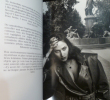Helmut Newton :
Work
Éditions Taschen, 2016, Broché, 280 pages.
Reference : AIX-2309
Très bon état.
Bookseller's contact details
Bouquinerie des Cinq Avenues
M. Alain Gilhodes
211 Boulevard de la Libération
13004 Marseille
France
bouquineriedescinqavenues@orange.fr
04 96 21 81 64
Payment mode
Sale conditions
Ventes fermes et comptant. Réglements chèques. Frais de port en sus. Les frais de port indiqués concernent la France et l'Europe, mais peuvent être plus importants au-delà de ces frontières et en fonction de l'évolution des tarifs postaux.
5 book(s) with the same title
Work as a Spiritual Practice: How to Bring Depth and Meaning to the Work You Do
Piatkus Books 1999 288 pages 15 2x2 2x23cm. 1999. Broché. 288 pages.
Bon état
Jean Stone Danos La Reduction Du Temps Work to Hospital
Bargain 2007 2007. Jean Stone Danos Bargain La Reduction Du Temps Work to Hospital The description of this item has been automatically translated. If you have any questions please feel free to contact us. 354-page paperback Berger Levrault editions; original edition 2002 book written in collaboration with Michel Garcia Gil Dominique Paris Christine Pinchon Laurence Raoust GOOD second hand Complete and solid without tears clean interior and still fresh few folds on the cover note that some lines (not many) are highlighted in green very rare. for France and Belgium sent by Mondial Relay (with follow-up towards a relay point ); shipment also with tracking for Austria Spain Italy United Kingdom Germany Portugal Luxembourg; for other countries abroad sent by registered mail; no sending for DOM TOM; for France sending always possible in colissimo by Post; at home so but it's more expensive. Perlenbook company n ° Siret 49982801100010. RCS Lure Tgi 499828911 N ° GESTION 2007 A 111. Created by eBay
Bon état
freinetberteloot Work Individualisé And Programming
Freinet 1966 1966. Freinet/Berteloot Work Individualisé And Programming 1966 The description of this item has been automatically translated. If you have any questions please feel free to contact us. paperback 144 pages (Modern School Library) a little worn (some small yellowing on covers or on a few -rare- pages) otherwise in GOOD CONDITION complete and solid without tears very few folds on the cover. for France and Belgium if other purchases are added the shipping costs increase very little if at all. for France can also be sent to your home (colissimo by post but it's more expensive). Created by eBay
Bon état
Lexicon (in Greek). Hesychii Dictionarium. - [A MAIN WORK OF LINGUISTICS - THE FIRST GREEK WORK PRINTED IN HAGUENAU]
(On colophon-leaf:) Haguenau, in aedibus Thomae Badensis, 1521). Small folio. Beautiful full calf binding over wooden boards. Recently rebacked. Beautiful blindstamped ornamental borders to boards and remains of clasps, ties missing. A few smaller wormhols to boards, and two drilled holes of ab. the same size to lower part of front board (for a chain?). Ornamented incunable-leaves with red and blue initials used as pasted-down end-papers. Front free end-paper soiled, with neat 19th century inscription (stating editions of the work), and with a beautiful large, engraved armorial book-plate (Collection of Bryan Hall). First leaf with a larger damp-spot to lower part (not affecting any text). Otherwise a very nice copy with only some minor light marginal soiling, a small dampstain to lower inner corner of last ab. 8 leaves, far from affecting text, and a bit of light spotting to a few leaves towards the end. Beautiful large woodcut printer's device to last leaf. (1) f., 776 columns (i.e. 388 pp/ 194 ff.), (1 - colophon) f.
The rare 3rd edition of Hesychios' extremely important Greek dictionary, one of the most important works of philology and linguistics ever printed, this edition constituting the first Greek work to be printed in the famous Renaissance printing-city of Hagenau/Haguenau (in Alsace).The first edition of the work was printed by Aldus in Venice in 1514, and in 1520 a re-impression appeared. The present third edition, edited by Marcus Musurus and printed after the edition of 1514 of Aldus Manutius, constitutes the second re-impression of the work, but it is the first to be printed in Hagenau and the first by the notable printer Thomas Anshelm, who had settled in Haguenau in 1516, being the first to seriously rival Henry Gran here. Anshelm is regarded as one of the most important printers of what we now call the Humanist period of the Renaissance. All three editions are rare and important.Hesychios of Alexandria was a highly important grammarian and lexicographer, whose only surviving work is the present lexicon of unusual and obscure Greek words, the richest of its kind ever. It is assumed that the work was executed by Hesychios during the 5th century. The work is extraordinary in that it constitutes a huge and unique listing of peculiar Greek words and phrases, with explanations and often references to the originator or place of origin. As such, the work is of the greatest value to the both the student of Greek dialects as well as for the ongoing work of restoring the texts of classical authors, for which the present lexicon it still an indispensible tool. But Hesychios' work is not only of the utmost importance to Greek philology, it is also a main work in the study of lost languages and obscure non-Greek dialects (e.g. Thracian and ancient Macedonian). Furthermore, the work was instrumental in the reconstruction of Proto-Indo-European, one of the most, if not THE most, important philological tasks ever. Only in the late 18th century did Jones determine the connection between the Indo-European languages, thereby founding comparative philology. Only a very corrupt manuscript, from the 15th century, of the work survives, and it is this manuscript that Marcus Musurus used as the basis for the first printing of the work by Aldus in 1514. As stated, two re-impressions (with modest corrections) appeared of this Aldus-edition (ours being the second), and since then no complete comparative edition of the manuscript has been published, bestowing on these three scarce early editions a huge importance. A modern edition of the seminal work has, however, been in intermittent publication since 1953. The editor of the last wolume states the following about Hesychios' Lexicon: ""Hesychius of Alexandria lived in the fifth century A.D. and compiled a dictionary of unusual or difficult Greek words with explanations in Greek. Approximately 51,000 entries make it the richest surviving Greek lexicon compiled until the invention of printing. It is of great importance to Ancient Greek studies because it contains countless words and expressions from poetry, administration, medicine, and so on, that are otherwise unknown or insufficiently explained. In particular, numerous words from the Greek dialects are important, not only for Greek but also for Indo-European philology.The Lexicon suffered substantial alterations, including abridgements and additions on its way from the author to the only surviving manuscript (fifteenth century). The production of an edition that gives all important information about the manuscript and the work of earlier scholars, as well as meeting modern requirements for the noting of parallels in other lexicographical works, is a slow and difficult task. Marcus Musurus published the first edition in 1514 (reprinted in 1520 and 1521 with modest revisions). There have since been many plans for an edition, but only four were started. Of the four editors, only one, M. Schmidt, lived long enough to finish the work himself. His edition (1858-68) is now completely out of date.A new edition was one of the most urgent requirements in Greek studies already when the German scholar KURT LATTE began preliminary work in the 1920s for the Danish Academy's Commission for Corpus Lexicographorum Graecorum. The project was severely hampered by the events of 1933-45. Volumes 1-2 were published in 1953 and (posthumously) 1966."" (Peter Allan Hansen, Editor of the final part of the great ongoing project of the new printing of the Hesychius-Lexicon)""Hesychius , (flourished 5th century ad), author of the most important Greek lexicon known from antiquity, valued as a basic authority for the dialects and vocabularies of ancient inscriptions, poetic text, and the Greek Church Fathers."" (British Encycl.).Though not of particular fame or importance today, the small city of Haguenau played a dominating role in the late 15th and the first half of the 16th century, then being one of the most important centres of printing. During the fifteenth and sixteenth centuries a remarkably large number of books were issued from presses in this small town, located close to Strasbourg. Thomas Anshelm (fl. 1488-1522) is considered perhaps the most eminent of the early Hagenau printers. He established himself as a printer in Basle in 1485 but subsequently worked as a printer in Strasbourg (1488), Pforzheim (1500-1511), Tübingen (1511-1516), and finally Hagenau (1516-1522), having by then developed his printing technique to perfection.Graesse III:266
Letters Concerning The English Nation. - [A KEY WORK OF THE HISTORY OF SCIENCE AND PHILOSOPHY]
London, 1733. 8vo. Bound in a lovely, contemporary English Cambridge-style full calf binding with a plain spine with five raised bands. Spine a bit cracked vertically and with minor loss to capitals. Corners a bit bumped and adges of boards a bit worn. Binding overall nice and tight. Small damp stain at the lower blank corner of the first few leaves, otherwise a very good, clean copy on thick, crisp paper. (16, -including preface, contents, advertisements), 253, (1), (18, -Index) pp.
The important actual first edition of this highly celebrated key work of the Enlightenment, in which the anecdote of how Newton discovered gravity (the story about Newton and the falling apple) appeared for the first time, together with the description of the difference between the physical world view of the English and the French (the ""plenum"" and the ""vacuum""). This seminal work, in which Voltaire famously depicts British philosophy, science, society and culture, in comparison to French, can be viewed as the Enlightenment equivalent to Tocqueville's ""Democracy in America"". This series of essays, which is based on Voltaire's experiences when living in England, was actually written by Voltaire mostly in English, which he mastered to perfection. It has often been presumed that the first edition of the work was that published in French in 1734, but actually, the present English edition constitutes the actual first appearance of the work as well as the version that is closest to Voltaire's intention, as the French language version is the re-written one, and the English version the original. Curiously, almost all modern English versions are translations into English of the French edition, instead of the original English version, making this edition of the utmost importance.After the original English edition of 1733, two French editions soon followed (the first in 1734). Unlike the British, the French resented the book, and already in 1734, the French Parliament issued an order for the author's arrest and condemned the work, causing the impact of it in France to be delayed. The book was burned for being ""dangerous to religion and civil order"". At the same time, the work became a bestseller in Britain, and as much as 14 editions of the work were published in the eighteenth century. ""Inspired by Voltaire's two-year stay in England (1726-8), this is one of the key works of the Enlightenment. Exactly contemporary with Gulliver's Travels and The Beggar's Opera, Voltaire's controversial pronouncements on politics, philosophy, religion, and literature have placed the Letters among the great Augustan satires. Voltaire wrote most of the book in English, in which he was fluent and witty, and it fast became a bestseller in Britain. He re-wrote it in French as the Lettres philosophiques, and current editions in English translate his French."" (Nicholas Cronk, Introduction to the Oxford's Classics edition from 1999).The great French philosopher Voltaire was greatly impressed by the philosophical and scientific achievements of the English, especially those of Newton, Locke, and Bacon. As a disseminator of scientific knowledge, Voltaire came to play a great rôle in the popularization of Newtonian science and its discoveries, the present work being a prime example. Although the work was condemned by the French authorities, it still came to play a great rôle in the spreading of Newtonian ideas in France. The present work generally came to play a dominant rôle in Enlightenment accounts of the history of science and philosophy. The work focuses on British science and thought and uses the accounts of these to emphasize what is lacking in French society and French thought. The work is generally very critical towards the French ""ancient régime"", and when Voltaire here discusses the emergence of empiricism, it is viewed as an English tradition that stands in opposition to the French rationalist tradition (with Descartes as the prime example). This view is taken over by the following Enlightenment historians of science and philosophy, e.g. d'Alembert (see for instance his ""Preliminary Discourse"" of 1751). Some of the most influential passages of the work are probably those on Bacon (who Voltaire sees as the founder of modern experimental science), Newton, and Descartes. Letters XIV, on Descartes and Newton, XV, on attraction, and XVI, on Newton's Optics (from 1704), are among the most influential essays of the work. In XVI Voltaire reflects upon Newton's ""Optics"" and the way that he rejected Descartes' theory and set out his own account of the properties of light. In XV he presents the first account of Newton and the falling apple: ""As he was walking one Day in his Garden, and saw some Fruits fall from a Tree, he fell into profound Meditation on that Gravity, the Cause of which had so long been sought, but in vain, by all the Philosophers, whilst the Vulgar think there is nothing mysterious in it. He said to himself, that from what height soever, in our Hemisphere, those Bodies might descend, their Fall wou'd certainly be in the Progression discover'd by Galileo" and the Spaces they run thro' would be as the Square of the Times. Why may not this Power which causes heavy Bodies to descend, and is the fame without any sensible Diminution at the remotest Distance from the Center of the Earth, or on the Summits of the highest Mountains" Why, said Sir Isaac, may not this Power extend as high as the Moon?..."" (pp. 127-28).But perhaps the most famous passage in the volume is the opening of Letter XIV: ""A Frenchman who arrives in London, will find Philosophy, like every Thing else, very much chang'd there. He had left the World a ""plenum"", and he now finds it a ""vacuum"". At Paris the Universe is seen, compos'd of Vortices of subtile Matter" but nothing like it is seen in London. In France, 'tis the Pressure of the Moon that causes the Tides but in England 'tis the Sea that gravitates towards the Moon" so that when you think that the Moon should make it Flood with us, those Gentlemen fancy it should be Ebb, which, very unluckily, cannot be prov'd..."" (pp. 109-10).
 Write to the booksellers
Write to the booksellers





